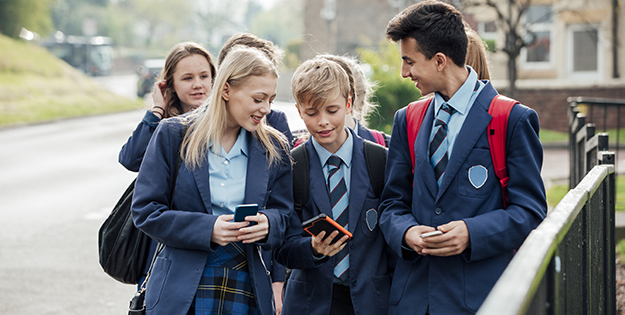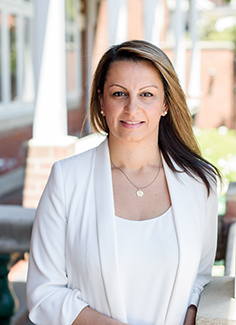Community
Copyright@ Australian Catholic University 1998-2025 | ABN 15 050 192 660 CRICOS registered provider: 00004G | PRV12008
Copyright@ Australian Catholic University 1998-2025 | ABN 15 050 192 660 CRICOS registered provider: 00004G | PRV12008

You don’t have to look very far to see people glued to their mobile phones.
It’s not only the schoolkids you see hunched over their screens at the bus stop: phone-obsessed adults are just as likely to have their heads buried in devices browsing Facebook, Twitter and the like.
The rising concern over smartphone “addiction” in young people has prompted legislators to take a bold stand.
Calls for a nationwide crackdown on phones in schools have followed moves to ban the devices from classrooms in NSW and Victoria.
In announcing his state’s phone prohibition, Victoria’s Education Minister James Merlino declared the ban would “help reduce distraction, tackle cyber bullying and improve learning outcomes for students”.
But some experts beg to differ.
“A blanket ban is absolutely the wrong approach to addressing these issues,” says ACU’s Associate Professor Miriam Tanti, whose research focuses on the impact of technological change on education.
“There is no evidence that it works, and in my view, it’s reactive and short-sighted.”
And she’s not alone. Educators have labelled the move to deprive children of the technology of their era as “moral panic”.
They make the point that digital devices are an inescapable part of modern-day life, and say children need to know how to use technology to learn, communicate and work with ideas.
However, not all experts agree.
Some psychologists point out that smartphones are often used at the expense of face-to-face communication, and raise concern about the risks of distraction and addiction.
Associate Professor Tanti does not deny these dangers; rather, she claims the classroom is an ideal environment for teaching kids to use technology in a safe and positive way.
Impact sat down with Professor Tanti, ACU’s Strathfield Campus Dean and Acting Head of School in NSW/ACT, to discuss the mobile phone debate.
“We know from experience that bans don’t work. In New York in 2015, the mobile phone ban they had in place was overturned by the mere consideration that it made it difficult for parents to contact their children. The other problem was that the ban was unequally enforced — it was much stricter at some schools than others — and that increases inequity across schools, but also within schools, because teachers won’t enforce the ban as strictly if they don’t support it.
Banning phones during school hours simply makes them more attractive to young people, and irrespective of the controls you put in place to regulate access to devices, students will work around them. When the NSW Department of Education reviewed smartphone policies around the world, it found that in schools restricting mobile phone use, 65 per cent of students still used them at school anyway. Kids are resourceful — they will find a way.”
“Distraction is and always will be a challenge in the classroom, but it was there long before the advent of digital technology. So the solution isn’t to ban mobile phones or remove technology from the classroom, it’s about creating activities or educational experiences that engage young people, that are authentic and meaningful and that connect young people to their real world.
“This is a really important piece of the puzzle for me: we are not recognising that young people are born into a world of digital ubiquity. Their view of technology is very different to ours. We tend to see parts of our lives as being either digital or non-digital, whereas young people see technology as just an extension of who they are. They don’t make that same distinction because they never had a time where it wasn't a part of their lives.”
“Absolutely. For adults, we grew up in a non-technological world. Technology is foreign to us, and many of us fear it and don't quite understand it. I think partly that’s due to the role the media has played in incorrectly reporting the facts. There’s a constant stream of propaganda directed towards parents that subscribes to the idea that social media is detrimental to children.

The evidence tends to point the other way. The 2017 UNICEF report Children in a Digital World shows the negative impact of technology on addiction and mental wellbeing is negligible, but if you look at the media’s reporting, the headlines tend to present the worst-case scenario and talk of mobile phone addiction in an over-inflamed way.”
“I think the classroom is an ideal place to manage that risk, because we can teach kids how to safely and appropriately use mobile phones and social media in a controlled environment, where they can make mistakes without any major consequences. If we put in a blanket ban that prevents us from doing that in a learning environment, what happens is that it goes underground, and that makes it more risky and dangerous, with far greater ramifications for young people.
As educators, we have a responsibility to teach children digital literacy and to embed it within the curriculum. It's no different to drug and alcohol education, or sex education, or driver safety. We don't ban all cars because people have car accidents. We don't say ‘don't swim’ because you might get caught in a rip. We educate people and teach them how to mitigate those risks.”
“In many ways it's not even about social media or digital technology, because the technology is merely the vehicle or the medium, and it’s actually the message that matters most. The real question is: What are you trying to do with that technology? That’s what my research and teaching aims to do: to answer that question and address it.
So let’s take a step back and address another question: What is the purpose of education? Is it about getting students to be great test-takers? Is it about having teachers stand at the front of the classroom to impart their knowledge on students, rather than allowing students to figure things out for themselves? If it is those things, then yes, let’s ban mobile phones. But education is not about all those things.
The purpose of education is to raise good human beings. In this era, we need to engage students in critical thinking, problem solving, decision-making, interpersonal skills, self-assessment, self-regulation, emotional skills and digital citizenship. And we can't do that in an artificial classroom environment that has no technology in it, because that does not replicate the real world. We need a robust and future-focused curriculum that embeds digital literacy and citizenship, in order to fulfil this notion of digital intelligence that’s underpinned in every single discipline.”
“At a very grassroots level, it’s simply teaching kids critical thinking and decision-making. We know that not everything posted on the Internet is credible, so a very important skill and a critical component of digital literacy is to learn to sift through all that information and discern what is credible and what isn't. In the era of clickbait and fake news, this is more and more important.
We can then provide students with a problem or scenario and allow them to use a range of resources — tech and non-tech — to come up with the best possible solution. And so students might use their phones to connect with experts via Twitter, or use augmented or virtual reality apps to bring their ideas to life. In this way they are engaging the experts in the field, seeking a range of opinions and views from all around the world and virtually prototyping their ideas before bringing the solution to fruition.
So you can see that this concept of only learning within the four walls of the classroom is really limiting. By using digital technology and social media, our learning can extend beyond those boundaries and expose students to different perspectives and different ways of viewing the world. We’ve seen how powerful social media can be; it’s created revolutions. It seems illogical that we would prevent students from engaging in a medium that can be so powerful.”
As the Acting Head of ACU’s School of Education in NSW and the ACT, Associate Professor Miriam Tanti prepares pre-service teachers to teach in contemporary learning environments, through the meaningful integration of digital technologies. Her book Slow in Education is due for release in late 2019.

Copyright@ Australian Catholic University 1998-2025 | ABN 15 050 192 660 CRICOS registered provider: 00004G | PRV12008